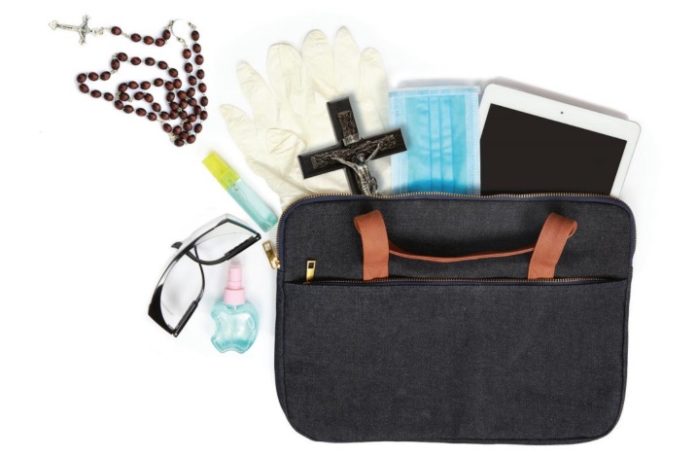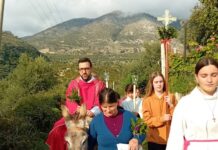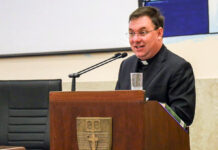How hospital chaplains are adapting to the challenges of COVID-19
By Tríona Doherty
Anyone who has ever been a patient or visitor in a hospital hospice or nursing home is aware of the vital role chaplains play in the life of the place. They support patients through illness or at the end of life and comfort anxious and grieving families. For many, they offer a kind face, a prayer or a sympathetic ear that is desperately needed during a difficult time. It is a ministry of presence – simply being with people and providing space for them to share their stories and their fears.
However, the COVID-19 restrictions of the past year have changed everything about healthcare, and that includes the way hospital chaplains carry out their ministry. Where once chaplains were free to pop in and out of wards, visits are now confined to a short time slot and generally only allowed when there is serious illness or end-of-life. In a time when patients are more vulnerable than ever, chaplains are coming up with new and innovative ways of bringing comfort to those in the hospital community.
“BACK TO BASICS”
Fr Michael Forde CSsR is a member of the chaplaincy team for several hospitals in Cork – St Finbarr’s Community Hospital, South Infirmary Victoria University Hospital, Farranlea Community Nursing Unit, and also occasionally on call to Cork University Hospital (CUH) and Mercy University Hospital.
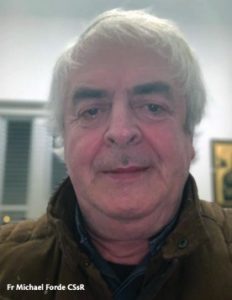 The most significant change, he says, is that there is a lot less contact with patients than in pre-Covid times. “Generally, when Covid is in a hospital, we only go where we are called, particularly to end-of-life situations or a situation where compassion is needed. It has changed the frequency of calls from the hospitals; now there has to be a definite reason or concern,” says Fr Michael.
The most significant change, he says, is that there is a lot less contact with patients than in pre-Covid times. “Generally, when Covid is in a hospital, we only go where we are called, particularly to end-of-life situations or a situation where compassion is needed. It has changed the frequency of calls from the hospitals; now there has to be a definite reason or concern,” says Fr Michael.
Like all healthcare workers, chaplains have been on a learning curve when it comes to the practicalities of dealing with COVID-19. Last April, at the start of the pandemic, Fr Michael and other clergy attended an online Zoom meeting with a panel of doctors to help them get to grips with PPE. It quickly became second nature, but there are knock-effects for interaction with patients. “The gear is very simple really – you decontaminate hands, put on apron, mask and goggles, and then follow the steps when removing them. But the big question is, how present can you be when covered in gear?” queries Fr Michael. “Even if the person is on a ventilator or unconscious, we always act on the presumption they can hear us, and we make sure to address the person directly. That was always the case, but it stands even more so now.”
End-of-life situations are particularly difficult, but they are handled with the utmost care. “Patients can’t have a big group of visitors, so we communicate with family members by phone to allow them to be with them. If they can’t have someone present, a staff member will be there. We can give last rites with care – the recommendation is to do the oil with a cotton bud. The thing to resist is to come in with the attitude of ‘Am I safe?’ The visit is not for us,” he stresses.
The increased use of technology to keep patients in touch with family and church has given Fr Michael inspiration for the future. “Zoom and other methods have helped in a positive way. They’ve especially impacted long-term residents in nursing homes, who are learning very quickly how to use them. Now that we are in the middle of using it, it’s a golden opportunity to grow this side of things,” he suggests. “We’ve had Mass via Facebook Live in St Finbarr’s and in Farranlea, so the wards can tune in, and CUH also has its own volunteer-run radio station that broadcasts ceremonies.”
Sadly, Eucharistic ministers can no longer function in healthcare settings, which he says is a “big casualty” of the pandemic. “People miss being able to receive Communion; they often say how much it means to them. There is a heavy emphasis at the moment on spiritual communion. It’s not the same as being present, but it gives people encouragement.”
He says one of the most significant losses in nursing homes has been the drop in interaction between residents. During the first lockdown, for example, residents of the community nursing unit had to stay in their rooms all the time, even having meals delivered. “They were really missing interaction with the other residents; they love to find out the news and hear what’s going on.” In St Finbarr’s, residents are no longer able to gather for Sunday Mass and meet up with the local regulars who also attended. “That community aspect is sorely missed,” says Fr Michael. “We haven’t been able to open the church since July, and we weren’t able to have a Christmas carol service with the staff choir.”
Fr Michael hopes that the pandemic has highlighted areas of chaplaincy that can be developed and improved. “The training up of men and women in the area of pastoral care needs a bit of a push. Priests and sisters have traditionally been at the interface. A lot of well-trained lay people are also working now, but we need more of an uptake. There is a great opportunity for the church to drive it and make it more feasible,” he says.
“With the pandemic the normal way of working doesn’t apply anymore. It’s all back to the basics of spending time with people. When this is over, we are going to evaluate things, and I think we’ll find that in a lot of ways, it’s been a positive thing.”
“SOMEONE TO TELL OUR STORIES TO”
Colette Furlong is a chaplain in Sligo University Hospital and North West Hospice and says the past year has been challenging on a number of levels.
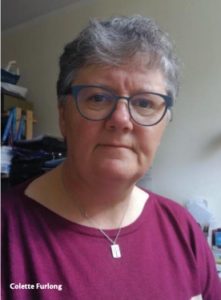 One of the first practical concerns she noted was the difficulty of having a conversation with patients through a mask and PPE gear. “It can be a challenge sometimes to make yourself heard. You are inclined to say less when you know someone can’t hear you and is getting frustrated; the last thing you want to do is exhaust people,” she reflects. “I’m conscious that 80-90 per cent of listening is done with the eyes, by reading facial expressions. That’s gone with the mask, and with full PPE even more so. Voices don’t sound the same. For the patient, it can be hard to distinguish who is a doctor, nurse, chaplain or even family coming into the room.”
One of the first practical concerns she noted was the difficulty of having a conversation with patients through a mask and PPE gear. “It can be a challenge sometimes to make yourself heard. You are inclined to say less when you know someone can’t hear you and is getting frustrated; the last thing you want to do is exhaust people,” she reflects. “I’m conscious that 80-90 per cent of listening is done with the eyes, by reading facial expressions. That’s gone with the mask, and with full PPE even more so. Voices don’t sound the same. For the patient, it can be hard to distinguish who is a doctor, nurse, chaplain or even family coming into the room.”
Colette says she has had to learn not to do the “normal” things she would have done previously when visiting a patient. “The policy is generally to touch nothing. Don’t even touch a chair to sit down. Don’t do the normal things. It is hard to restrain yourself, but you do what you have to do. I look forward to the day when I can sit beside a bed and put my hand on the person’s arm and even whisper to them, ‘Don’t worry, you’ll get through this.”‘
The one thing that is lacking in her visits with patients is time. “I find it often takes a bit of time for patients to settle and to really talk,” she says. “There are times that people want to talk but don’t know how. Before COVID-19, we could take the time. When we listen to a person telling their story, it becomes meaningful to them in the process. We don’t get to do that right now, and patients miss out on a moment that can be enriching.
“Our icebreakers in Ireland are the weather and ‘I’m grand’ – they serve a purpose. But now, all the ‘faff’ is cut out, and people feel they have to get straight down to business, and there’s an anxiety that comes with that. We’re not great at it; we like to go around the hills before we get to the point! It’s in the faff that the human situation is.”
Colette says she misses the opportunity to build up a rapport with patients, as chaplains are only called in when someone is in a serious condition. “People have a huge need for meaning in life, and this really comes to the fore when we’re sick. We need someone to be present, someone to tell our stories to. There’s a mourning process that begins for people, and they have to rewrite their story. As chaplains, we can’t do this for them, but we can accompany them to a place of discovery. It’s part of the hospital journey,” she explains.
“But now, we can’t build up that rapport We are meeting patients when they’re already in trouble. When a person is at one of the worst moments of their life, our role is to stand in their pain with them. Now, we’re not getting there until they are beyond that pain and are dying; often they are not responsive. We are still standing with them, but I don’t feel we can offer as much.”
She says the staff are “brilliant”, and their concern is always for the patient’s wellbeing. Families have been extremely innovative in communicating with their loved ones. “If a patient is close to end of life, they are generally in a private room, and this is the only circumstance where visitors are let in. Feelings run high, but I have yet to see anyone get irate. Families have been so creative. One person might visit and do a WhatsApp call with other family members. I have done a decade of the Rosary with a patient, with family joining in from America and Australia, and we all prayed together.”
However, Colette says the shared moments of liturgy and gathering are missed. “We’ve always had a chapel channel on the hospital TVs. We closed the chapel doors now for the celebration of Mass via a camera. We rely on the staff to let people know about the channel. In each ward, we used to be able to ask if anyone would like Holy Communion; now nurses will send for us only if a patient requests it.
“We couldn’t have our memorial service last November for babies and children who have died. We pre-recorded some of the parents and staff involved in that area and held the service online. But we are missing the humanity of gathering together and sharing stories, having a cup of tea. Those ritual moments really matter.”
“AN IMMENSE PRIVILEGE”
Fr Sean O’Donnell is one of the Catholic chaplains serving the Altnagelvin Group of Hospitals along with Fr Michael Canny, Fr Malachy Gallagher and Fr Daniel McFaul. Fr Sean feels that his role “changed dramatically” in March 2020 when the usual programme of ward visitation had to be suspended.
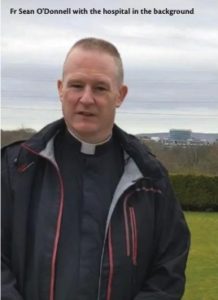 “We then had to rely on the ward staff to communicate with us as to who needed a visit. The Trust provided a system of mobile phones to chaplains as well as a mobile or tablet device to each ward. This meant that we could use video calls to chat with, pray and encourage patients and thus cut out the physical visiting as much as possible.” says Fr Sean. “Staff became innovative at getting family members and chaplains all on one ward device, and we all adapted and did what we could for the patient’s spiritual welfare and also for their family while ensuring everyone was kept safe at the same time.”
“We then had to rely on the ward staff to communicate with us as to who needed a visit. The Trust provided a system of mobile phones to chaplains as well as a mobile or tablet device to each ward. This meant that we could use video calls to chat with, pray and encourage patients and thus cut out the physical visiting as much as possible.” says Fr Sean. “Staff became innovative at getting family members and chaplains all on one ward device, and we all adapted and did what we could for the patient’s spiritual welfare and also for their family while ensuring everyone was kept safe at the same time.”
Certain incidents stick in the mind that highlight what a strange year it has been. “Fr Canny recollects a day that he was called to anoint a lady in end-of-life care who didn’t have COVID-19. She had a large family. It was a ground-floor ward, and some of the family had gathered around the window outside her room while he was inside with their mother. Then he met with them outside afterwards. This is so different and sad, and it will be a difficult memory for them, yet at the same time, they understood that this was the way it had be in these times,” says Fr Sean.
To administer sacraments, chaplains are required to wear foil PPE, another new experience. “At the bedside and in full PPE we could use the ward device to have family members join us as we administer the sacraments. The changing into scrubs, donning and doffing PPE, meant that a visit that may have taken 20-30 minutes maximum before now took at least an hour or more. But it is the wonderful privilege of our chaplain ministry to be able to be with the faithful when they need us most. One just needs to be aware of how precious such a visit is to all involved so that enough time is available to make the visit.”
Prayer Packs have been distributed to patients, containing a letter from the chaplaincy team with contact details, a rosary, a miraculous medal and some prayer literature. “Even these small gifts are of consolation,” says Fr Sean. “Holistic care is about treating the whole person, and looking after their spiritual and pastoral needs can aid and speed up a person’s recovery.”
Part of the role is also to support staff, and staff have become more aware that the chaplains are there for them, not just the patients. “I have seen the intensity of care given – the relentless nature of what is required from the staff especially during the peaks of COVID-19. In addition to their normal attention, they also have to maintain regular contact with families via audio and visual means. Not to mention the wearing of PPE,” he says.
“Their determination to do the best they can for those in their care is obvious to all who see it. The loss they feel when a patient passes away, the joy when a patient heads home, are part of the rollercoaster of emotions they have to cope with. At Altnagelvin, we are so blessed to have not just their skill, but their compassion and determination to do more than just a job.”
One initiative which has proven popular is a Prayer Tree in the hospital prayer room, made up of leaf post-its on which staff write their thoughts and prayers. “We meet as chaplains each Sunday at 3 pm in the hospital to pray together for all patients and staff. These prayer requests are held in that prayer time and are also remembered during the Saturday ‘Hospital Mass’ [currently celebrated in a local church].”
While it has been a challenging year, the team have adapted as best they can. “It is so encouraging when I receive a face-to-face acknowledgement, a phone call a text message or a card in the post from patients, staff and families. These are received after happy or sad outcomes and are a beautiful reminder to me of how important the vocation of chaplain is to them,” says Fr Sean.
“I never lose sight of the plan God has for each of us and continue to answer God’s call in what I consider to be an immense privilege and duty to see Christ in those who are in our hospitals.”
Courtesy: Reality magazine, April 2021



